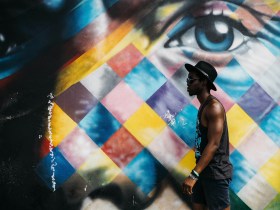Image: Laura Boynes
Three gifted dancers, each proven choreographers in their own right, working with Patrice Smith on the brief of expressing what we feel when we are approaching our limits – Verge was never going to be a run-of-the-mill production.
A darkened room, stage space totally bare, edgy sound effects – nearly music, more noises that tap into the centres of irritation and impatience in our minds – and subtle lighting, showing one dancer clearly and leaving the other two on the edges of shadows. Bernadette Lewis opened the show, with jerky tumbling motions, clumsily collapsing and picking herself up again and again. The other dancers remained at the back of the stage, gently rocking and turning in place, but each stepping forward to take turns as human props for Lewis to flop against and ricochet off. The sense of trepidation in Lewis’ movements was exquisite, heightened by her positioning herself so that she was teetering on the edge of the light. After inching her way backwards on an invisible tightrope she exploded, setting off the other two dancers, allowing the indulgence of release and bodies flinging themselves about the place and bouncing off the cladded walls for an extra sonic dimension.
Jacqui Claus took the floor, commencing in a twilit tableau as we listened to the stylings of a didgeridoo, tranquil after the preceding storm. Claus took her time, so slowly, so controlled, channelling the ache of anticipation through her excruciatingly gradual contortions. She reset the pace of performance, but the mood remained anguished, pushing buttons of expectation and appearing physically painful (although Claus made it all appear elegantly easy to execute). The artist’s repression of expression, restraint and personal control took us through this section.
Laura Boynes took the frenzy of relief another step further, and then another step, as she dashed about the stage in the most accessible section of performance. Her desperation to reach her destination was palpable, as was her despair each time she fell or was overtaken by one of the other dancers, easily passing her on their ways elsewhere. Boynes used her facial expressions to convey her emotional states clearly, the fear of being left behind, frustration at her own limitations, hopeless, wordless cries for help.
Verge treated Blue Room audiences to a killer soundtrack featuring grimy, gritty beats, some spectacular lighting and the close to flawless technique of three talented dancers, but partly because of its premise, partly due to time restrictions, it lacked a sense of cohesion as a whole. Some allowance for the development of a context outside the explanatory notes of the program may have helped, but the sense of unease that the various sections fostered in the audience did not lend itself to an evening of straightforward entertainment.
Verge shows promise for further development as it explores some difficult aspects of the human condition, but does not yet come together as a self-contained performance.
2.5 stars
Verge
Presented by The Blue Room Theatre, Sally Richardson and Patrice Smith
Choreographer: Patrice Smith
Music composition / Lighting Design: Joe Lui
Set / Costume Design: Fiona Bruce & Lauren Ross
Stage Manager: Rhianne Perrie
Marketing / Publicist: Mira Radmilovich
Production Photography: Ashley de Prazer
Season Producers: Patrice Smith and Sally Richardson
Performed by Jacqui Claus, Laura Boynes and Bernadette Lewis, with Yilin Kong as understudy
The Blue Room Theatre, Perth Cultural Centre
Alternating with Standing Bird 2
13 – 30 November 2013





